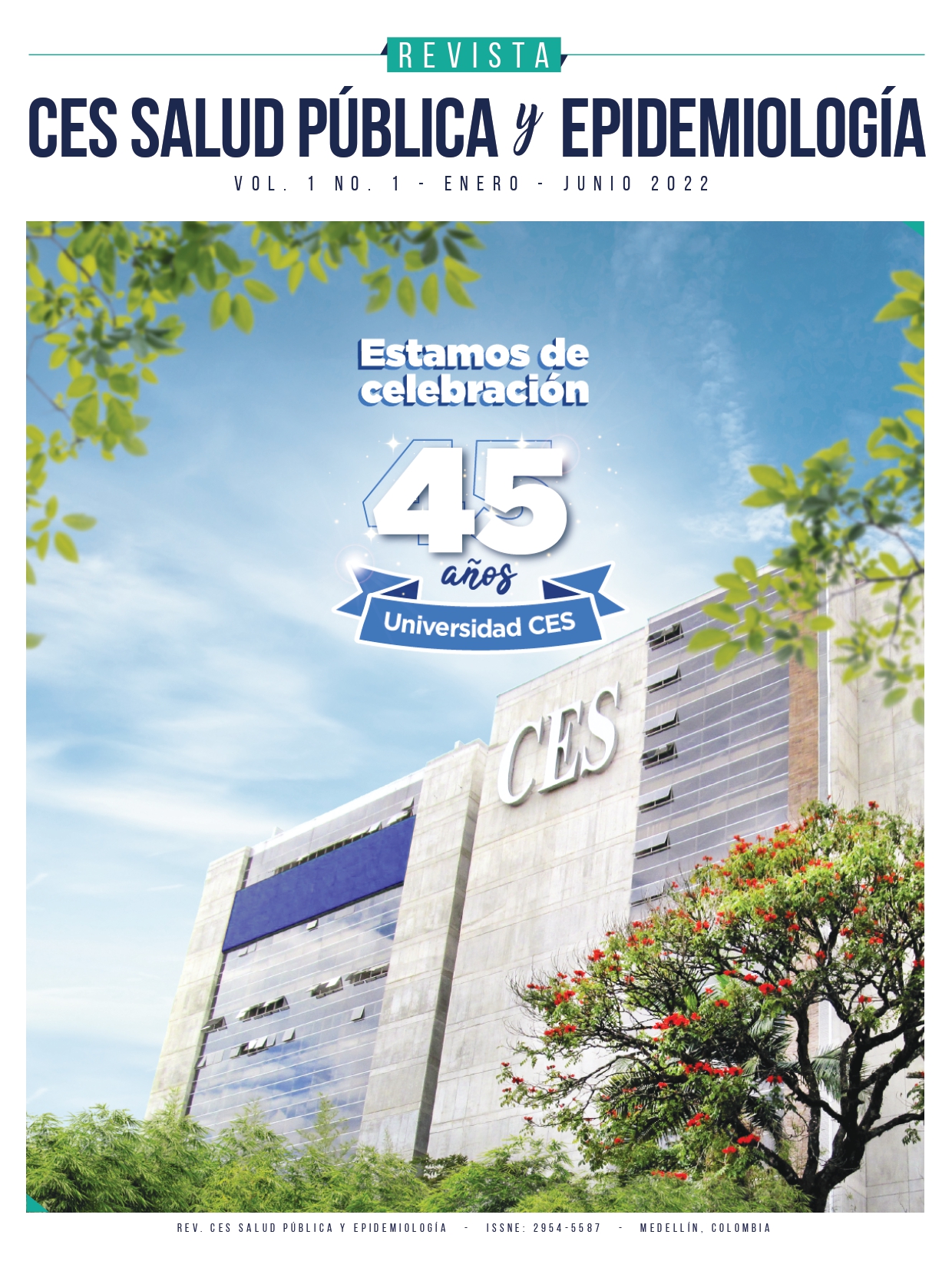Pioderma gangrenoso y colitis ulcerativa. Reporte de Caso
DOI:
https://doi.org/10.21615/cesspe.6662Palabras clave:
pioderma gangrenoso, colitis ulcerosa, úlcera cutánea, dermatosis neutrofílicaResumen
Antecedentes: el pioderma gangrenoso es una enfermedad cutánea crónica inflamatoria que pertenece a las dermatosis neutrofílicas, es poco frecuente y su patogenia es desconocida. Se caracteriza por presentar clásicamente nódulos o pústulas de aparición más común en miembros inferiores que en poco tiempo progresan a ulceración dolorosa con bordes sobreelevados, de color eritematovioláceo y fondo sucio de aspecto necrótico. El 70 % de los casos se asocia con otros trastornos sistémicos, siendo la enfermedad inflamatoria intestinal una de las más frecuentes. Caso clínico: se describe el caso de una paciente de 64 años que cursó con lesiones papulo-eritematosas en axila y glúteo con progresión a úlceras dolorosas de características típicas de pioderma gangrenoso, asociado a deposiciones sanguinolentas. Se estableció diagnóstico de colitis ulcerosa mediante histopatología de colon y de pioderma por la presencia de lesiones cutáneas típicas, con histopatología que no fue sugestiva de otra entidad. Recibió tratamiento con ciclosporina, mesalazina y prednisolona, con múltiples recaídas; finalmente, se indicó manejo con terapia biológica logrando control de la enfermedad. Conclusión: se presentó el caso de una paciente con diagnóstico de pioderma gangrenoso, con la intención de describir su evolución y características clínicas típicas, exponiendo imágenes clínicas representativas de lesiones activas y en su fase de cicatriz.
Descargas
Referencias bibliográficas
Brocq L. Nouvelle contribution a l'etude du phagedenisme geo-metrique. Ann Dermatol Syphiligr. 1916;6(1):1- 39
Brunsting LA, Goeckerman WH, O'Leary PA. Pyoderma [ecthyma] gangrenosum: Clinical and experimental observations in five cases occurring in adults. Arch DermatolSyph. 1930;22:655- 680.
Ruocco E, Sangiuliano S, Gravina A, Miranda A, Nicoletti G. Pyoderma gangrenosum: an updated review. J Eur Acad Dermatol Venereol. 2009;23(9):1008- 1017
Ben Abdallah, H., Bech, R., Fogh, K., Olesen, A. B., & Vestergaard, C. (2021). Comorbidities, mortality and survival in patients with pyoderma gangrenosum: a Danish nationwide registry‐nested case–control study. British Journal of Dermatology. doi: 10.1111/bjd.20474
Ashchyan HJ, Butler DC, Nelson CA, et al. The association of age with clinical presentation and comorbidities of pyoderma gangre-nosum. JAMA Dermatol. 2018;154(4):409- 413.
Flora A, Kozera E, Frew JW. Pyoderma gangrenosum: A systematic review of the molecular characteristics of disease. Exp Dermatol. 2022;31:498– 515. doi: 10.1111/exd.14534
Ahronowitz I, Harp J, Shinkai K. Etiology and management of pyo-derma gangrenosum: a comprehensive review. Am J Clin Dermatol. 2012;13(3):191- 211
Byrd AS, Carmona-Rivera C, O'Neil LJ, et al. Neutrophil ex-tracellular traps, B cells, and type I interferons contribute to immune dysregulation in hidradenitis suppurativa. Sci Transl Med. 2019;11(508):eaav5908
White LE, Villa MT, Petronic-Rosic V, Jiang J, Medenica MM. Pyoderma gangrenosum related to a new granulocyte colony- stimulating factor. Skinmed. 2006;5(2):96- 98.
Schadt, Courtney. "Pyoderma Gangrenosum: Pathogenesis, Clinical Features, and Diagnosis." Uptodate. Ed. Jeffrey Callen and Abena O. Ofori. N.p., 14 Oct. 2016. Web. 10 Apr. 2017.
Marzano AV, Ishak RS, Saibeni S, Crosti C, Meroni PL, Cugno M. Autoinflammatory skin disorders in inflammatory bowel diseases, pyoderma gangrenosum and Sweet's syndrome: a comprehensive review and disease classification criteria. Clin Rev Allergy Immunol. 2013;45:202-10
20 Sasor SE, Soleimani T, Chu MW, Cook JA, Nicksic PJ, Tholpady SS. Pyoderma gangrenosum demographics, treatments, and outcomes: an analysis of 2,273 cases. J Wound Care. 2018;27:S4-8.
Kutlubay Z, Tuzun Y, Wolf R. The pathergy test as a diagnostic tool. Skinmed. 2017;15:97-104.
Rodríguez-Zúñiga MJM, Heath MS, Gontijo JRV, Ortega-Loayza AG. Pyoderma gangrenosum: a review with special emphasis on Latin America literature. An Bras Dermatol. 2019;94:729-43.
D. Wallach, M.D. Vignon-Pennamen, A.V. Marzano (Eds.), Neutrophilic Dermatoses, Springer, Cham, Switzerland (2018), pp. 5-9
Feldmeyer, L., Ribero, S., Gloor, A. D., & Borradori, L. (2020). Neutrophilic dermatoses with unusual and atypical presentations: both superficial and deep. Clinics in Dermatology. doi: 10.1016/j.clindermatol.2020.10.012
George, C., Deroide, F., & Rustin, M. (2019). Pyoderma gangrenosum - a guide to diagnosis and management . Clinical medicine (London, England), 19(3), 224–228. https://doi.org/10.7861/clinmedicine.19-3-224
Ighani, A., Al-Mutairi, D., Rahmani, A., Weizman, A. V., Piguet, V., & Alavi, A. (2018). Pyoderma gangrenosum and its impact on quality of life: a multicentre, prospective study. British Journal of Dermatology. doi: 10.1111/bjd.17347
Nusbaum, K. B., Ortega-Loayza, A. G., & Kaffenberger, B. H. (2021). Health-related domains of quality of life in pyoderma gangrenosum: A qualitative analysis. Journal of the American Academy of Dermatology.
Weenig, R. H., Davis, M. D. P., Dahl, P. R., & Su, W. P. D. (2002). Skin Ulcers Misdiagnosed as Pyoderma Gangrenosum. New England Journal of Medicine, 347(18), 1412–1418. doi: 10.1056/nejmoa013383
Descargas
Publicado
Cómo citar
Número
Sección
Licencia
Derechos de autor 2022 CES Salud Pública y Epidemiología

Esta obra está bajo una licencia internacional Creative Commons Atribución-NoComercial-CompartirIgual 4.0.
Derechos de reproducción (copyright)
Cada manuscrito se acompañará de una declaración en la que se especifique que los materiales son inéditos, que no han sido publicados anteriormente en formato impreso o electrónico y que no se presentarán a ningún otro medio antes de conocer la decisión de la revista. En todo caso, cualquier publicación anterior, sea en forma impresa o electrónica, deberá darse a conocer a la redacción por escrito.
Plagios, duplicaciones totales o parciales, traduccones del original a otro idioma son de responsabilidad exclusiva de los autores el envío.
Los autores adjuntarán una declaración firmada indicando que, si el manuscrito se acepta para su publicación, los derechos de reproducción son propiedad exclusiva de la Revista CES Salud Pública y Epidemiología.
Se solicita a los autores que proporcionen la información completa acerca de cualquier beca o subvención recibida de una entidad comercial u otro grupo con intereses privados, u otro organismo, para costear parcial o totalmente el trabajo en que se basa el artículo.
Los autores tienen la responsabilidad de obtener los permisos necesarios para reproducir cualquier material protegido por derechos de reproducción. El manuscrito se acompañará de la carta original que otorgue ese permiso y en ella debe especificarse con exactitud el número del cuadro o figura o el texto exacto que se citará y cómo se usará, así como la referencia bibliográfica completa.



